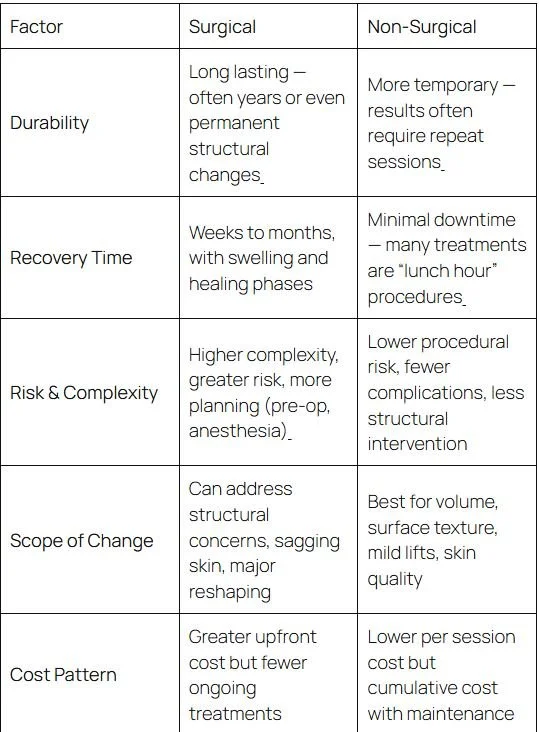What Patients Need to Know About Surgical vs. Non-Surgical Options
Choosing between surgical and non-surgical cosmetic treatments is about alignment with your goals, anatomy, risk tolerance, and lifestyle. Below is a guide to help you understand key differences, benefits, limitations, and decision factors in a thoughtful, evidence-based way.
Defining the Options: Surgical vs. Non-Surgical
Surgical procedures involve incisions, anesthesia, tissue removal or repositioning, and a recovery period. Examples include facelifts, rhinoplasty, eyelid surgery, and neck lifts.
Non-surgical treatments are minimally invasive (or non-invasive), with no large incisions or general anesthesia. Common methods include Botox®, dermal fillers, laser resurfacing, chemical peels, ultrasound, and radiofrequency skin tightening.
Longevity, Down Time, & Magnitude of Change
Although both surgical and non-surgical treatments aim to enhance facial aesthetics, they do so through very different means. Understanding how each option performs in terms of duration, recovery, risk, and overall transformation can help patients make informed, realistic choices. The chart below summarizes the core distinctions at a glance:
When to Choose Surgical or Non-Surgical Options
Surgical approaches often excel when structural changes are required, such as repositioning fat, tightening loose skin, or reshaping bone or cartilage. These are scenarios where non-invasive treatments simply lack the mechanical leverage.
Non-surgical methods shine when your goals involve surface smoothing, volume restoration, fine lines, or skin tone improvement — and when downtime must be minimal.
The Role of Combination & Staged Plans
In many cases, the best approach is hybrid or staged care. You might start with non-surgical treatments to “test the waters” or maintain results, followed later by surgical enhancement if a more dramatic change is desired. This also allows you to space investment over time, see how tissues respond, and adjust plans accordingly.
What to Ask When Evaluating a Provider
What is your complication rate for this procedure?
How often do you perform the exact procedure I’m considering?
Can I see before/after results and long-term follow-ups for your patients?
How do you manage patient expectations and revise plans if outcomes vary?
What is the realistic duration of this option for my unique anatomy?
Final Takeaway
Surgical and non-surgical pathways each have strengths and limits. The right choice depends on the magnitude of change you seek, your tolerance for downtime and risk, and your long-term vision. When considered judiciously, both strategies can be complementary.
Disclaimer: This content is for educational purposes only and does not constitute medical advice.
